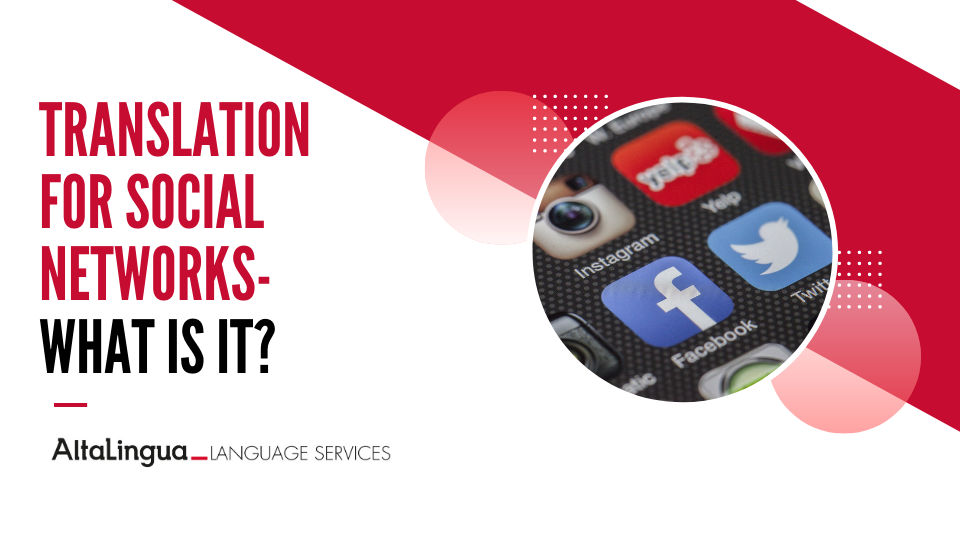-
Translation for social networks – What is it?
Social networks are part of the daily life of many Internet users today, and many businesses use them with the aim of developing their online marketing strategies.
The commercial use of social networks for exchanging and sharing information with users and customers is called Social Business, it is one of the most important current trends. These strategies allow businesses to join international markets and promote new professional opportunities.
It is key that translations for social networks are carried out by native translators, with extensive knowledge of the culture and language of the target country.
Each social network has its own specifics and the format of each support, while often quite short, involves brevity in the writing and a very direct content with a very clear message that uses a specific form of writing for social networks (emoticons, hashtags, etc.) to develop the tone of the message, boost its spread, etc. Due to all the characteristic of social networks, the translator has to be creative and astute to translate both the format and the tone and nuances of the message.
Each social network has its own specific features, when it comes to translating it is necessary to keep in mind those so that the translate is more correct and better suited to each platform and user where the message is directed.
We are going to provide some recommendations for the translation of contents of the most used social networks by businesses.
 Translation for Facebook
Translation for FacebookIt is the social network with the most market penetration, businesses can realise, generate demand and boost sales. With 1.2 billion people that use it every day, Facebook is determined as the most consulted social network and has an immense visibility to potential customers.
Facebook pages for businesses, are a fundamental part of the strategy for the development of the online image do any business in any sector. Boosting your spread to lead to a creation of demand, favouring loyalty and dialogue with users.
On the other hand, generally, businesses post news and developments to services and products, a professional translation being fundamental for the development of promotional and commercial goals in the different markets. There are no size limitations for the content, therefore Facebook allows a certain freedom on its posts.
 Translation for Twitter
Translation for TwitterThe most direct social network between a business and its target audience. The main goal of the tweets, messages of 140 characters as maximum, is to create a network and spread information.
Twitter allows you to attract traffic to the business’s website, generating conversations with the user, measuring the quality of your own services and boosting the spread and the image of the business. The users act as advertisers mentioning and tweeting information at the time, a channel of information where the primacy and spontaneity of the content prevails.
The translation also has to respect the 140 character limit, a challenge so that the message in the target language is as precise as in the original language. For example, the abbreviations and hashtags that are used for an idiomatic version, may not be the same for a translation suited for a different market.
 Translation for LinkedIn
Translation for LinkedInThe best professional social network. If offers specific contents oriented to professionals from our surroundings or sector.
LinkedIn favours the creation of networking, the exchange or information between businesses, collaborators and professional markets. LinkedIn is a very powerful tool to generate a brand image in specific professional sectors.
The translation of contents for LinkedIn, as well as for every professional business communication, must be carried out by professional translators, native in the target language and with knowledge of the terminology that applies to the particular sector of the business.
The greater the degree of specialisation of the contents, the greater the need for a technical translator with experience in the corresponding area.
7 translation tips for social networks
1. Set a strategy.
Before you translate all your social media content, it is important to decide which languages to translate into, and to take into account their regional variants.
Likewise, once the languages have been defined, you must determine the correct register to be used, in order to avoid diluting the message as well as to adjust it to the social network in question.
2. Plan your content.
Correctly scheduling your social media posts will help you to translate their contents well in advance.
Setting a schedule for your posts can be very useful for time management and error prevention. For this, you can use different tools such as Buffer or Hootsuite.
3. Act fast.
Social networks are user structures linked by a common criterion where immediate communication and updates are essential. This urgency requires advance planning if you are to translate the contents and upload them within a short period of time.
4. Adapt your contet to your social network.
One of the biggest challenges involves character limits, as depending on the social network in question, there may be more or less restrictions.
While Facebook and LinkedIn let you make lengthy posts, Twitter limits you to 280 characters, which poses a complication when adapting the message to the target language.
For an exact count of the number of words in a message, Word or Excel can be very handy tools.
5. Respect keywords.
The copywriter and community manager work very hard to incorporate SEO keywords into the contents of your blog and social media posts.
This step is essential for a good ranking in search engines and for greater visibility and interaction, which is why they must be respected and adapted into the target language and country, always maintaining their original meaning and purpose.
6. Have a standard operating procedure.
All content published on social networks is likely to generate reactions from users, either with you or with each other. This interactivity requires a quick response, which is why it is important to create a document with standard responses as guidelines for the translator.
Literal translations on social networks are never ideal, therefore, it is important to have a margin of time to adapt the content to the target language and the audience in question.
This is why literal translations don’t work on social networks, because a standard expression in the original language doesn’t necessarily have the same meaning or connotation in the target language.
7. The universal nature of emoticons.
People speak different languages, but emoticons constitute universal speech in social media. Using them to better express a content or even replacing words with emojis will lead to greater interaction and comprehension.

What language is most frequently used in social networks?
According to data published by the Internet World Stats 2019, the world’s largest communications network or the Internet has more than 4.3 billion users.
Internet World Stats also publishes a ranking of the 10 most widely used languages in the Internet, sorted by the total number of Internet users per language. It shows that English is the most highly ranked language with nearly 1.1 billion users, followed by Chinese with almost 864 million users, and Spanish with nearly 345 million users.
Most of the information that we find on the Internet is in English, regardless of the format, whether they are academic texts, social media posts, audio files, videos or ebooks, among others.
Users and companies seek to attract more user traffic and greater dissemination. What better way to achieve this than by posting in the language with the greatest number of Internet users worldwide?
So, yes, spoiler alert! English is the language most frequently spoken by Internet users and the second most frequent is Chinese, but when it comes to social media, the first language is English followed by Spanish, according to a report published by the Instituto Cervantes.
So now you know that if you want to expand your scope, you should translate your content into the two most important languages in social networks.
AltaLingua
AltaLingua is a trusted name in the translation and interpreting sector and provides language solutions in all languages for clients across the world. https://altalingua.co.uk/
- altalingua@altalingua.co.uk
- Customer Area
